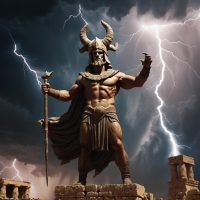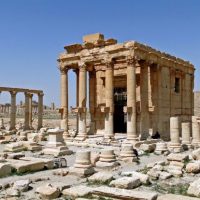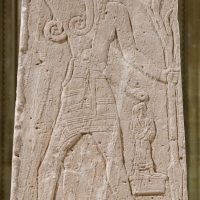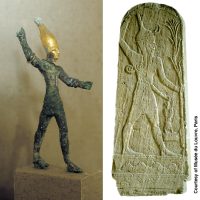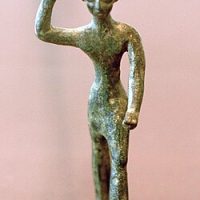Baal : The Storm God
Listen
At a glance
| Description | |
|---|---|
| Origin | Canaanite Mythology |
| Classification | Gods |
| Family Members | El (Father), Athirat (Mother), Anat (Sister) |
| Region | Lebanon |
| Associated With | Syria, Lebanon, Israel, Egypt, and Tunisia |
Baal
Introduction
Baal, one of the most prominent gods of the ancient Near East, was worshipped widely across Canaan, Phoenicia, and Syria. His name comes from the Semitic word baʿal, meaning “lord” or “master,” and over time it became a title applied to many local deities. Yet, in Ugaritic texts from the city of Ugarit, Baal emerges as a specific, powerful god of storms, fertility, and kingship. He was regarded as the force that brought rain, making agriculture possible in a land where survival depended on seasonal cycles. Baal’s stories in the Ugaritic Baal Cycle emphasize his role as the guarantor of life, engaged in epic struggles against chaotic forces such as Yamm, the sea god, and Mot, the god of death. These myths explain not only natural phenomena like drought and rainfall but also reflect deeper ideas of cosmic order, renewal, and divine authority.
Physical Traits
Ancient depictions of Baal present him as a vigorous warrior with commanding features. He is often shown raising a thunderbolt in one hand while striding forward, his posture symbolizing dominance over the forces of nature. The thunderbolt was his most recognizable attribute, representing both destruction and life-giving rain. Another common motif was the bull, an animal associated with virility and agricultural fertility. Stelae and bronze figures found at Ugarit and other Levantine sites reveal Baal wearing a tall conical crown or a horned helmet, markers of his divinity and strength. These artistic portrayals combine human and divine qualities, underscoring his dual role as a fierce storm god and a bringer of abundance to the land.
Family
Baal’s divine family connections reflect the complex structure of the Canaanite pantheon. In Ugaritic mythology, he is frequently described as the son of El, the supreme god, and Athirat (Asherah), the mother of the gods, though other traditions link him to Dagan as his father. His close companion and sometimes consort is the goddess Anat, a fierce and warlike deity who plays a crucial role in rescuing him from death. Baal’s encounters with Mot highlight the cycle of fertility and drought, as his death plunges the land into barrenness, while his revival restores life and abundance. He is also credited with fathering minor deities such as Pidray, Tallay, and Arsay, who personify aspects of dew, light, and moisture. This divine kinship situates Baal not only as a storm god but as an essential force in the web of life and death.
Other Names
The title “Baal” was widely used across the ancient Levant, and many towns had their own local Baals. In Ugaritic texts, he is often called “Rider of the Clouds,” a title emphasizing his role as the storm bringer who traversed the skies. Other epithets include “Prince, Lord of the Earth,” and “Victorious Baal,” reflecting his triumphs over hostile deities. Regional adaptations produced variations such as Baal Shamen, or “Lord of the Heavens,” in Phoenicia; Baal Zephon, associated with navigation and protection, in Egypt; and Baal Hammon in Carthage, later linked to agricultural fertility and even child sacrifice in Roman accounts. Over time, his identity merged with storm gods like Hadad of Mesopotamia and Teshub of the Hurrians, showing his influence beyond the Canaanite world. The plural form, Baalim, referred to the many localized versions of the god across the Levant.
Powers and Abilities
Baal’s power was rooted in his dominion over storms, rain, and fertility. As a storm god, he controlled the life-sustaining rains that ensured crops grew and animals thrived. He was believed to ride the clouds, unleashing thunder and lightning that announced his presence. In myth, Baal’s battles demonstrated his ability to subdue chaos and preserve balance. His combat with Yamm, the sea god, represented his triumph over the untamed waters and established him as ruler of the cosmos. Armed with weapons forged by the divine craftsman Kothar-wa-Hasis, Baal’s victory symbolized order conquering disorder. His ongoing struggle with Mot, the god of death and sterility, dramatized the seasonal cycles of drought and fertility. Baal’s temporary defeat at Mot’s hands brought dryness and famine, but his eventual return guaranteed renewal. In this way, Baal embodied both vulnerability and resilience, reflecting the agricultural rhythm of ancient life.
Modern Day Influences
Although Baal worship declined with the spread of monotheistic religions, his legacy continues to shape cultural and religious thought. In the Hebrew Bible, Baal is portrayed as a rival to the God of Israel, with prophets denouncing his worship as idolatry. This negative portrayal influenced later Jewish, Christian, and Islamic traditions, where Baal became associated with demonic figures, most notably Beelzebub, often described as the “Lord of the Flies.” Archaeological discoveries, such as tablets from Ugarit, have provided scholars with a deeper understanding of his role in Canaanite religion and its impact on biblical narratives. In comparative mythology, Baal has been linked to gods like Zeus, Jupiter, and Thor, highlighting his central place among storm deities across cultures. In modern literature and art, Baal often symbolizes rebellion, chaos, or untamed natural power. Writers like Bertolt Brecht and contemporary fantasy creators have reimagined him in new contexts, while neopagan groups occasionally reference Baal as part of their reconstruction of ancient polytheism. His enduring presence in both religious polemic and cultural imagination ensures that Baal remains a figure of fascination in discussions of mythology, history, and theology.
Related Images
Source
Hjelm, T. (2021). Baal. In World History Encyclopedia. Retrieved from https://www.worldhistory.org/baal/
Smith, M. (2017). Baal (mythology). EBSCO Research Starters in Social Sciences and Humanities.
Britannica Editors. (1998). Baal | Definition, Myths, Worship, & Facts. Encyclopaedia Britannica. https://www.britannica.com/topic/Baal-ancient-deity
StorytellingDB. (2025). The Role of Baal in Canaanite Mythology: Storm God and Fertility Deity. https://storytellingdb.com/baal-canaanite/
Facts and Details. (2012). Canaanite Gods | Middle East and North Africa. https://africame.factsanddetails.com/article/entry-747.html
Wikipedia contributors. (2025). Baal. Wikipedia. https://en.wikipedia.org/wiki/Baal
Study.com. (2022). Canaanite Religion Mythology & Religious Practices. https://study.com/academy/lesson/canaanite-religion-overview-gods.html
Study.com. (1999). God Baal Origin, Worship & Biblical Significance. https://study.com/academy/lesson/baal-god-origin-biblical-significance.html
Frequently Asked Questions
What is lorem Ipsum?
I am text block. Click edit button to change this text. Lorem ipsum dolor sit amet, consectetur adipiscing elit. Ut elit tellus, luctus nec ullamcorper mattis, pulvinar dapibus leo.
What is lorem Ipsum?
I am text block. Click edit button to change this text. Lorem ipsum dolor sit amet, consectetur adipiscing elit. Ut elit tellus, luctus nec ullamcorper mattis, pulvinar dapibus leo.
What is lorem Ipsum?
I am text block. Click edit button to change this text. Lorem ipsum dolor sit amet, consectetur adipiscing elit. Ut elit tellus, luctus nec ullamcorper mattis, pulvinar dapibus leo.
What is lorem Ipsum?
I am text block. Click edit button to change this text. Lorem ipsum dolor sit amet, consectetur adipiscing elit. Ut elit tellus, luctus nec ullamcorper mattis, pulvinar dapibus leo.
What is lorem Ipsum?
I am text block. Click edit button to change this text. Lorem ipsum dolor sit amet, consectetur adipiscing elit. Ut elit tellus, luctus nec ullamcorper mattis, pulvinar dapibus leo.


